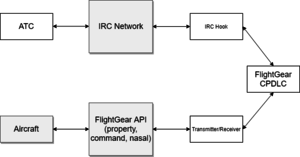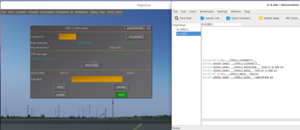Hackathon Proposal: CPDLC
This is the original material for the CPDLC proposal, published and edited in the run-up to the Virtual FSWeekend Hackathon 2020, followed by the delivered results. It contains outdated/wrong information.
Issues/ideas
The following could be done in the hackathon:
- write the Nasal to exchange the right data with the outside system;
- write the IRC hook to connect FlightGear to IRC (not least a generic capability, that other applications may use)
- involving core dev's at least for the design choice, a way to get rid of the middleware eventually, e.g. allow Nasal connections to FG-approved servers (like irc.flightgear.org) or integrate specific accesses in the C++ code base (sort of the same history as FGCom, going from standalone executables to an option in the FG menu)?
- can someone create a sketch of a block diagram of the elements that need to communicate and the connections between them? -- p callahan Done -- J Redpath
The block diagram describes how such a system might operate. The crucial elements are the IRC Hook and the FlightGear API. These are what the aircraft / ATC talk to directly, and therefore where input and output occur.
The IRC hook will require elements such as:
- Connection
- Respond to PING
- Disconnection
- Transmit and receive PRIVMSG to a specified UID
- Error handling - if UID does not exist, if server disconnects, if ...
The FlightGear API will require elements such as:
- Connection
- Disconnection
- Transmit + receive message element (including message history as a vector)
One option is to have a /sim/network/cpcdlc/received/ message sender status .. etc ….
and then an additional
/sim/network/cpcdlc/signals/message-received
Then in C++ you fill in all the ‘received’ values from your socket callback, and fire value changed on the signal property. This will allow a Nasal listener to process the received data.
For message history, you could either have multiple received nodes (e.g. received[0], [1], [2]) or else a Nasal hook that accesses a vector.
For transmitted messages, a similar scheme would work; however, what would probably be better would be:
fgcommand(‘cpcdlc-transmit’, props.Node.new({‘receient’:’blah’, ‘mesage’:’foobarzot’,<etc, etc>});
We’d use the same to establish the connection:
fgcommand(‘cpcdlc-connect’, props.Node.new({ ’server’: “foo.bar.com’, ‘port’ : 666, ‘callsign’ : ‘wibble’, <etc, etc? ‘recv-path’ : ‘/sim/network/cpcdlc/received’, ‘recv-signal’ : /sim/network/cpcdlc/signals/received' });
Available ATC-pie IRC scheme
When connected to an IRC server, e.g. irc.flightgear.org, ATC-pie features an integrated text chat system for ATCs to coordinate off the (public) FG text chat. The choice of IRC and plain text lines was in part motivated by the possibility for users of other clients (e.g. OpenRadar) still to take part via their own IRC client.
The connection is also used to embed special commands, in the form of escaped text lines, starting with ___ATC-pie___ , e.g. for strip exchange (handovers) or "who-has" requests. Commands were later added to support CPDLC, which is ready for ACFT to connect. What follows is a description of those CPDLC-related commands.
Note that the IRC nicknames are assumed to match the FGMS network callsigns, so the first line sent after connection is always:
NICK <callsign>\r\n
Then, from an ACFT point of view, every CPDLC command is sent to the current (or requested) data authority (ATC) via an escaped chat message line:
PRIVMSG <atc> :___ATC-pie___ <command_line>\r\n
Command lines that an aircraft can send to an ATC are:
CPDLC_CONNECT: attempt log-onCPDLC_MSG <msg_contents>: connected CPDLC dialogue message (see below)CPDLC_DISCONNECT: connection shut down
Command lines that an aircraft can receive from an ATC are:
CPDLC_CONNECT: accepted log-on, or new data authority (link has been transferred)CPDLC_MSG <msg_contents>: connected CPDLC dialogue msg (see below)CPDLC_DISCONNECT: connection voluntarily dropped by ATC, or refused log-on
The contents of connected dialogue messages (contained in CPDLC_MSG lines) can be discussed as part of the interface between aircraft and ATC-pie, but for the moment they are of either format below:
REQUEST <display_text>(<sep_char><encoded_instruction>)*: likely answered with an INSTR msgINSTR <display_text>(<sep_char><encoded_instruction>)*: never sent by ACFT, only receivedACK: acknowledgement/"WILCO"REJECT <optional_reason>TEXT <free_text>
Results
We have a proof of concept up and running :)
- Basic IRC protocol has been implemented in C++
- Some dummy CPDLC messages have been successfully passed around
- CPDLC connect/disconnect works, handover to othe ATS unit works
- Inbound CPDLC messages are processed and queued for later display in the cockpit
- A simple PUI dialog interface is available in FGAddon

